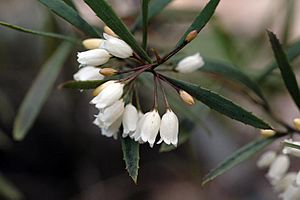Willowy eremophila facts for kids
Quick facts for kids Willowy eremophila |
|
|---|---|
 |
|
| Scientific classification | |
| Genus: |
Eremophila (plant)
|
| Species: |
saligna
|
| Synonyms | |
|
|
The Eremophila saligna, also known as the willowy eremophila, is a beautiful flowering plant. It belongs to the figwort family (Scrophulariaceae). This plant is special because it is endemic to Western Australia. This means it naturally grows only in Western Australia and nowhere else in the world! It's an upright shrub with long, thin leaves that have tiny saw-like edges. Its flowers are shaped like tubes and are usually cream or white.
Contents
What Does the Willowy Eremophila Look Like?
The willowy eremophila is an upright shrub that can grow quite tall, usually between 0.9 and 4 meters (about 3 to 13 feet) high. The tips of its branches are flat and often look shiny because they are covered in a sticky substance called resin. These branches also have small, raised bumps.
Leaves and Branches
The leaves of this plant grow one after another along the branches. They are narrow and shaped like a spear or an oval. They are shiny and sticky, just like the branch tips. Each leaf is usually between 30 and 60 millimeters (about 1 to 2.5 inches) long and 3 to 7 millimeters (about 0.1 to 0.3 inches) wide. They are smooth and have a few small, saw-like edges.
Flowers and Fruits
The flowers of the willowy eremophila grow in groups of up to five in the spots where leaves meet the stem. They sit on straight, smooth, sticky stalks that are about 7.5 to 11 millimeters (0.3 to 0.4 inches) long. Each flower has five green, sticky, triangle-shaped sepals that are about 1.2 to 2.2 millimeters long.
The petals are joined together at the bottom to form a tube, which is about 7 to 10 millimeters (0.3 to 0.4 inches) long. This tube is usually cream-colored and sometimes has purple spots inside. The outside of the petal tube is smooth. However, the inside of the petal tips has small, tongue-shaped hairs, and the lower part of the tube has club-shaped hairs. The four stamens, which are the parts that produce pollen, are hidden inside the petal tube.
The willowy eremophila usually flowers between August and October. After the flowers bloom, they produce dry, thin, and fragile fruits. These fruits have four sides and are about 5.5 to 10 millimeters (0.2 to 0.4 inches) long.
How Was This Plant Named?
The willowy eremophila was first officially described in 1899 by a botanist named Spencer Le Marchant Moore. He initially called it Pholidia saligna. Later, in 1931, another botanist named Charles Gardner changed its name to Eremophila saligna. The word saligna comes from Latin and means "of willow." This name was chosen because the plant's leaves look a lot like the leaves of a willow tree.
Where Does the Willowy Eremophila Grow?
You can find E. saligna growing on and around rocky hills, and sometimes near salt lakes. It grows in areas between Esperance, Coolgardie, and Marvel Loch in Western Australia. These areas include different natural regions like the Avon Wheatbelt, Coolgardie, Esperance Plains, Mallee, and Nullarbor.
Is the Willowy Eremophila Protected?
The Western Australian Government's Department of Parks and Wildlife has classified Eremophila saligna as "not threatened." This means that currently, there are enough of these plants, and they are not in danger of disappearing.
Growing Willowy Eremophila in Your Garden
This plant is one of the toughest and easiest to grow among the larger eremophilas. In early spring, it produces many pale cream-colored flowers that have a lovely vanilla-like smell. The flowering period is usually short, but it's a beautiful sight!
You can easily grow new plants from cuttings (small pieces of the plant). It can grow well in many different types of soil, even those that are alkaline (not acidic) or have a lot of clay. This plant is also very good at handling dry weather and frost. It can survive long periods without needing extra water, which makes it a great choice for gardens in dry areas.

